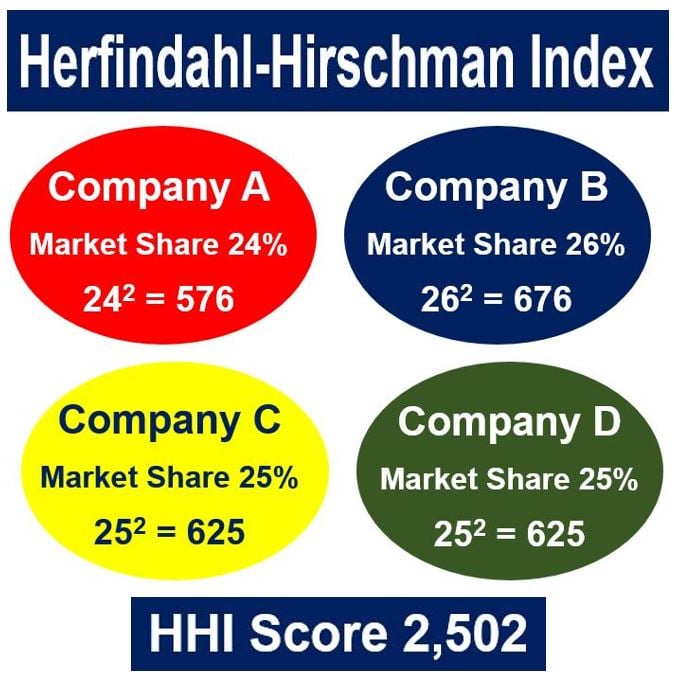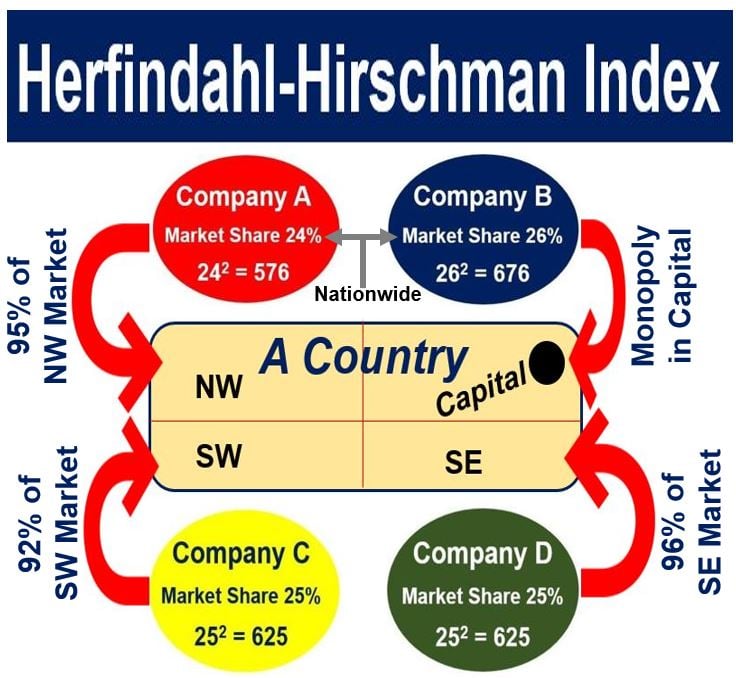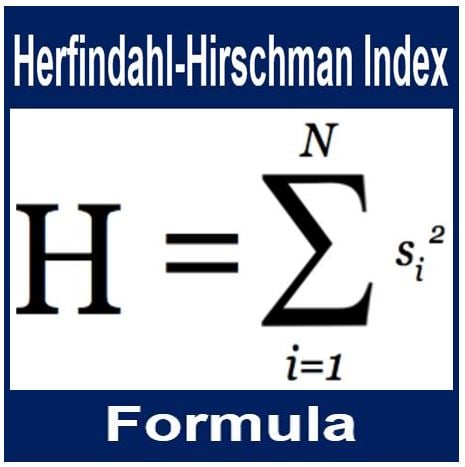The Herfindahl-Hirschman Index, also called the Herfindahl Index, measures the extent to which market share is concentrated among a few or many companies. It measures market concentration of an industry’s fifty biggest firms in order to determine whether that industry has a healthy number of competitors or is nearing monopoly.
It is calculated by squaring the market share of each competitor and then summing the resulting numbers. For example, if a market has four competitors with market shares of 30%, 30%, 20% and 20%, the Herfindahl-Hirschman Index is 2,600, which is the sum of 302, 302 + 202 + 202.
 A Herfindahl-Hirschman Index score of about 2,500 suggests that the market has an ‘oligopoly’ – it is controlled by very few companies.
A Herfindahl-Hirschman Index score of about 2,500 suggests that the market has an ‘oligopoly’ – it is controlled by very few companies.
Relevance of Herfindahl-Hirschman Index score
The Herfindahl-Hirschman Index (HHI) takes into account the relative size distribution of the companies that compete in a market. The larger the number of firms of relatively equal size the nearer to zero it approaches, and reaches its 10,000 maximum points when a market is controlled by just one firm.
If there are 100 competitors, they have 1% each of the market – 12 added one hundred times equals 100. In a monopoly, the firm has 100% of the market – 1002 equals 10,000.
The HHI gets larger both as the number of competitors in the market declines and as the disparity in size between those companies gets larger.
According to the US Department of Justice:
“The agencies generally consider markets in which the HHI is between 1,500 and 2,500 points to be moderately concentrated, and consider markets in which the HHI is in excess of 2,500 points to be highly concentrated.”
If the Herfindahl-Hirschman Index is 100 – there are 100 competitors, antitrust agencies will see this as a market close to perfect competition. If the score is 2,500 – there are just four competitors – it suggests an oligopoly. When it reaches 10,000, it is a monopoly.
 When market share is calculated nationwide, it seems unlikely that consumers would suffer from monopolistic practices. However, in this case they are vulnerable because each company has a virtual monopoly in specific regions of the country. HHI is a tool, and as with any trade, the tools used can only be as good as the people who use them.
When market share is calculated nationwide, it seems unlikely that consumers would suffer from monopolistic practices. However, in this case they are vulnerable because each company has a virtual monopoly in specific regions of the country. HHI is a tool, and as with any trade, the tools used can only be as good as the people who use them.
Nasdaq.com says that the HHI is:
“A measure of market concentration, it depends on the number of firms and their size relative to the market. It is calculated by summing up the squares of market shares of each firm.”
“Mergers or acquisitions that change the HHI by more than 100 points in a concentrated market may raise antitrust concerns within the Department of Justice.”
The HHI was named after Orris Clemens Herfindahl (1918-1972), an American economist who studied natural resources, and Albert Otto Hirschman (1915-2012), an influential German economist and the author of a number of books on political ideology and political economy.
Limits of the Herfindahl–Hirschman Index
The usefulness of the Herfindahl–Hirschman Index is directly dependent on how correctly or appropriately a particular market has been defined.
For example, let’s say we are looking at the number of companies competing in the financial services sector. In this fictional scenario, we find that it contains five main companies that have 18% market share each. It would seem that the sector is non-monopolistic, wouldn’t it?
However, one of those competitors handles ninety percent of all checking and savings accounts and physical branches, while the others are mainly involved in investments and commercial banking.
 Si represents a company’s market share – the overall equation squares them and sums them up for each firm in a market. The more firms present in a market (N), the more balanced their market shares are, the lower the sum (H). (Image: priceonomics.com)
Si represents a company’s market share – the overall equation squares them and sums them up for each firm in a market. The more firms present in a market (N), the more balanced their market shares are, the lower the sum (H). (Image: priceonomics.com)
The firm that dominates the checking and savings accounts sub-sector also overcharges its customers because of its dominant position. Even though no monopoly would have been detected, customers are suffering because of monopolistic practices.
An industry or sector is defined primarily on the notion of substitutability. In the case of this example, the market has not been properly defined because checking accounts cannot be substituted with investment and commercial banking.
The problems of defining an industry or sector can work the other way round as well. For example, if one cinema company had ninety percent of the cinema market, we would immediately conclude it was a monopoly.
However, if cinemas (movie theaters) – which compete against online services like Netflix, pubs, nightclubs and DVD suppliers – only accounted for 20% of all movies people watched, then customers would less likely be suffering due to monopolistic practices.
In this second example, the market to be analyzed should have been ‘movie viewing’ rather than ‘movie theaters’.
There are several industries that appear competitive when the Herfindahl-Hirschman Index is calculated at national level but monopolistic at regional levels.
Imagine a country that has six main mobile phone providers; they control approximately 15% of the market each.
However, Company A has 95% of the market in the southeast of the country, Company B has 92% of the market in the capital (which makes up 30% of the nation’s population), Company C is virtually the only provider in the northwest, etc.
Video 4-firm HHI – Identifying market structures
This video shows how you can identify market structures using the Herfindahl-Hirschman Index and the 4-Firm Concentration Ratio.
